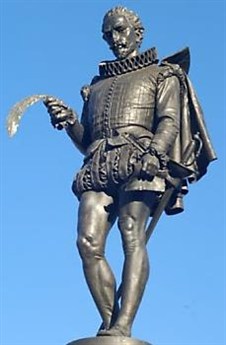Miguel de Cervantes Saavedra
 Miguel de Cervantes Saavedra (1547-1616) is the principal author of Spanish literature, one of the most important figures of all European literature. Born in Alcalá de Henares to a large and modest family, in 1568 he moved to Italy to avoid the condemnation of the cutting off of his right hand and ten years of exile for the wounding of a certain Antonio de Segura. In 1571 he took part, on the galley Marquesa, in the Battle of Lepanto, during which he was wounded and lost the use of his left hand forever. Four years later, while returning to Spain, the ship on which he was traveling was attacked by pirates and Cervantes was taken to Algiers and sold as a slave. After 5 years of imprisonment and several failed escape attempts, he was finally able to return to Spain in 1580, but his personal adventures and misadventures were not finished yet. In addition to the brief and unhappy marriage to Catalina de Salazar y Palacios (married in 1584), Cervantes worked as a commissioner in Andalusia for the supply of food to the Invencible Armada, but ended up in jail in Seville in 1602 for administrative offenses. He again did jail time, for a short time, in Valladolid, when he was wrongly accused of the murder of a knight. Embittered by the insinuations about the morality of his sisters and his natural daughter Isabel, Cervantes moved to Madrid in 1606 to be close to the court of Philip III and remained there until his death. His most famous work is undoubtedly the novel El ingenioso hidalgo Don Quijote de la Mancha, an absolute masterpiece of European Baroque literature published in two parts in 1605 and 1615, and yet it could not guarantee him a more comfortable life. After his pastoral novel Galatea (1585), his later works include: Novelas ejemplares (1613), El viaje del Parnaso (1614), Ocho Comedias y ocho entremeses (1615, in particular the comedy Pedro de Urdemalas and the interlude El retablo de las maravillas) and Los trabajos de Persiles y Sigismunda (posthumous, 1616).
Miguel de Cervantes Saavedra (1547-1616) is the principal author of Spanish literature, one of the most important figures of all European literature. Born in Alcalá de Henares to a large and modest family, in 1568 he moved to Italy to avoid the condemnation of the cutting off of his right hand and ten years of exile for the wounding of a certain Antonio de Segura. In 1571 he took part, on the galley Marquesa, in the Battle of Lepanto, during which he was wounded and lost the use of his left hand forever. Four years later, while returning to Spain, the ship on which he was traveling was attacked by pirates and Cervantes was taken to Algiers and sold as a slave. After 5 years of imprisonment and several failed escape attempts, he was finally able to return to Spain in 1580, but his personal adventures and misadventures were not finished yet. In addition to the brief and unhappy marriage to Catalina de Salazar y Palacios (married in 1584), Cervantes worked as a commissioner in Andalusia for the supply of food to the Invencible Armada, but ended up in jail in Seville in 1602 for administrative offenses. He again did jail time, for a short time, in Valladolid, when he was wrongly accused of the murder of a knight. Embittered by the insinuations about the morality of his sisters and his natural daughter Isabel, Cervantes moved to Madrid in 1606 to be close to the court of Philip III and remained there until his death. His most famous work is undoubtedly the novel El ingenioso hidalgo Don Quijote de la Mancha, an absolute masterpiece of European Baroque literature published in two parts in 1605 and 1615, and yet it could not guarantee him a more comfortable life. After his pastoral novel Galatea (1585), his later works include: Novelas ejemplares (1613), El viaje del Parnaso (1614), Ocho Comedias y ocho entremeses (1615, in particular the comedy Pedro de Urdemalas and the interlude El retablo de las maravillas) and Los trabajos de Persiles y Sigismunda (posthumous, 1616).
Read more:
- J. Canavaggio, Cervantes, Madrid 2004.
- M. Fernández Álvarez, Cervantes visto por un historiador, Madrid 2005.
- M. Duran, F.R. Rogg, Fighting Windmills: Encounters with Don Quixote, Yale University Press 2006.
